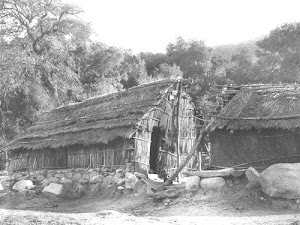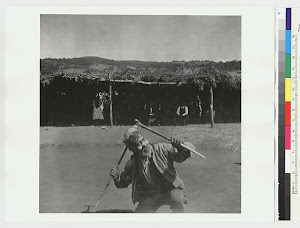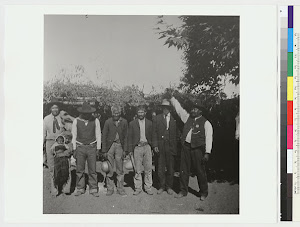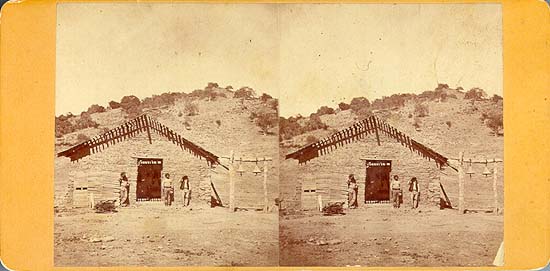




MASTER APPRENTICE TRAINING IN KUGLUKTUK
February, 2010
L. Frank and Leanne Hinton spent the last week of February far north of the Arctic Circle, in the hamlet of Kugluktuk, in the province of Nunavut, Canada. Temperatures were as low as -54°F, a great adventure for coastal California gals. (Even the locals thought that was pretty cold.) The village is on the Coronation Inlet of the Arctic Ocean, all frozen solid until the ice breakup comes in mid-June. This time of year, “ice-roads” are built on the lakes, and people cross over the inlet to islands on their snowmobiles, unlike the summer when they turn to their boats for these crossings. The “Tree Line,” some forty miles south of Kugluktuk is the magical place where trees start to grow. The plants of summer around Kugluktuk are lush, but tiny, hugging the ground. This time of year, of course, there is only the vast expanses of white snow.
Millie Kuliktana and her co-worker Susie had brought us up there to give a Master-Apprentice training workshop. 3 years ago they had gone to a Master-Apprentice workshop Leanne gave in Victoria, and it went to their hearts. “It was about me and my grandmother!” Millie said. They felt this was the exact thing they needed for language revitalization in Kugluktuk, where the language is rarely heard nowadays. Despite the fact that there are still some grandmothers unilingual in Inuinnaqtun, Millie can’t think of a single household that uses the language any more other than the elders’ homes, and young adults have grown up speaking only English. They’ve been working for the last 3 years to get their community ready for a Master-Apprentice program. “Language revitalization” wasn’t a word anyone was thinking about in Nunavut before now, they told us. The speakers, too, are ready. They completely understand the process, and are delighted to be part of it.
Attending the workshop were the master-apprentice teams themselves, and a group of “Foundation” students – students at the beginning of a training program for teachers. Normally in Nunavut’s Foundation program, students are expected to already know the language. But because of language loss in Kugluktuk and other villages in Western Nunavut, the majority of these students did not grow up knowing Inuinnaqtun, so language learning has to be a part of their program.
Everyone was tremendously friendly and hospitable to us. L. Frank was especially popular, not only because of her charismatic self, but also because of her tattoos. Many adults remember the facial tattoos of their grandmothers, and some are trying to gather the knowledge and courage to get their own faces tattooed. One participant told us that her grandmother used to tell her about how as a girl, she thought the faces of her mother and grandmother were so beautiful, and could hardly wait til adulthood so that she too could get tattooed – and when the day came, how beautiful she felt herself to be.
Millie, her sister Edna (who is doing the program evaluation), and Susie already have a good background in Total Physical Response language teaching methods, and are quite obviously excellent teachers and trainers themselves. They improved the experience of the workshop participants at every turn with their great ideas and inspirational comments. This was a 5 day workshop – unusually long, but the organizers were wise to set it up this way. It allowed us not only to show them what to do, but to have people really get into the program, so that by the end of the week real language learning was taking place.
During the workshop, the participants did many of the standard immersion sets that we use in training; but the fun really started when we asked the participants to think of three action verbs they would like to practice in an immersion set – and did they pick basic verbs like “run,” “stand up” and “sit down”? Noooo. They picked “square dance,” “waltz,” and ‘jig.” So then we did an immersion set where learners had to listen to the words in Inuinnaqtun and do the correct dance; but then, the masters remembered that square dances used to have instructions in the language, and began teaching those. In the end we did the square dance immersion set once or twice each day, with Edna calling out the Inuinaqtun words for moves such as “dosado,” “allemande left,” and “forward and back.”
Another great immersion activity was planned in detail by the organizers, where the master-apprentice teams had to prepare a lunch for everyone, all in Inuinnaqtun. The learners not only heard and practiced lots of language, but also learned the old ways of butchering and preparing meat, vegetables and bannock (Canadian fry bread). Our menu included roast caribou, caribou stew, dried caribou, caribou marrow caribou blood soup and caribou feet; also baked char, frozen char, and char-head soup; beluga whale blubber and skin; bannock, and several salads. One young woman was particularly moved, because it was the first time she had ever made bannock herself. “Now I can make it for my husband,” she said.
There were also immersion sets involving drum dancing and singing, Inuit wrestling games and all kinds of string-figures. But probably the most meaningful moment of all was when Kate, a unilingual master speaker of Inuinnaqtun, came in one morning with a traditional stone seal oil lamp -- a shallow bowl shaped as a half-circle. In front of her rapt audience, she filled the lamp with oil, set up a row of plant fluff that acted as wicks, and worked to strike a spark with a flint against a rock with a thin cotton scrap on it to catch the spark. (You can also use dried moss.) She managed to catch a spark and blow it into a flame, and light the lamp. Most people in the room had never seen this done before, and it was a magical moment when the wicks took flame. Kate recounted (all in Inuinnaqtun) that when she was a little girl living with her parents in an igloo, the lighting of the lamp was always a dramatic moment. The lamp was the source of all heat, light and cooking. She remembers crying with relief sometimes when the lamp was finally started after some difficulty, knowing that now they would be warm.
We talked about the importance of bringing the language home and out to the community. Maimi, one of the masters, said (in Inuinnaqtun) “When you see me around the hamlet, make sure you speak in Inuinnaqtun to me If you use English, I won’t respond.” Toward the end of the week, we started focusing on language in the family, since most of the learners have young children. We did immersion sets of simple commands that can be understood readily with gestures, a good way to start introducing the children to the language – things like “Come here,” “Put your coat on,” “come eat,” and so on. Almost all the learners have children at home, and they came back the next day full of success – the children understood them, and loved it. One young woman said she gave her child a bath, and named the body parts as she washed them. Her little girl was so delighted she kept saying “More! More!” So the next day we all did “Bath-time” immersion sets.
At the beginning of the week, the learners had seemed scared and unconfident; but by the end of the week, it was as if the Inuinnaqtun language had been locked up and was now freed. When asked to name the main ideas they learned, the chalkboard filled with phrases, like patience, repetition, put away the paper, leave English behind, gaining confidence; have fun; focus on a few words at a time, useful phrases, use it all over community, bring it home. One learner said “I learned more language this week than in my whole life!” Others said “Now I know I can learn it.” Millie said “Over the next years, you learners will be the leaders of language revitalization. We are going to take this program across all of Nunavut!” The lighting of the seal oil lamp was a great symbol for the workshop. In the same way, the spark of language is itself being relit in Kugluktuk.
Leanne Hinton
L. Frank
March 3, 2010
Tuesday, March 16, 2010
MASTER APPRENTICE TRAINING IN KUGLUKTUK
Posted by
Karen Vigneault Librarian
at
11:09 AM
![]()
Subscribe to:
Post Comments (Atom)













No comments:
Post a Comment